Слайд 2How do we know how Old English was pronounced?
Obviously there are no

recordings.
Largely guesswork but not totally.
Слайд 3
Grounds for reconstruction of Old English/Anglo-Saxon pronunciation:
1) As all new written

languages, Old English had predominantly phonetic spelling;
2) Comparison with cognate langugages (German, Scandinavian languages);
3) Comparison with Modern English (changes not arbitrary but follow sound laws; without a sound law there is no reason to believe the pronunciation has changed).
Слайд 4Anglo-Saxon manuscript: “Beowulf” beginning

Слайд 5This is what the text might have sounded like
http://www.youtube.com/watch?v=LP2FyVbymTg
http://www.youtube.com/watch?v=4L7VTH8ii_8

Слайд 6Beowulf (lines 210 – 218)
Starting with line 210
Fyrst forð gewāt.

Flota wæs on ŷðum,
bāt under beorge. Beornas gearwe
on stefn stigon; strēamas wundon,
sund wið sande; secgas bǽron
on bearm nacan beorhte frǽtwe,
gūðsearo geatolīc; guman ūt scufon,
weras on wilsīð, wudu bundenne.
Gewāt þā ofer wægholm, winde gefŷsed,
flota fāmiheals fūgle gelicost,
Слайд 7For reading, check also the following link
http://www.beowulftranslations.net/beorefs/beowulf-audio-0194a-0224a-benslade.mp3

Слайд 8Peculiarities of Old English pronunciation and spelling
/f/ and /v/ were allophones, i.e.

there was
no phonemic difference between them:
no minimal pairs where /f/ and /v/ would
make a difference in meaning
The letter f used for both. In a voiced environment
the pronunciation voiced, ie /v/, in a voiceless
environment – unvoiced, ie /f/. At the beginning of
words: debatable.
Слайд 9By constrast, vowel length was phonemic:
man /man/ – human being, man
mān /ma

:n/ - evil; witchcraft (cf Estonian
“manala”, “mana”, “manama”)
Слайд 10In old manuscripts vowel length
indicated by ´ (like a stress mark),

in modern editions a strike over the
vowel.
Слайд 11The scribes proceeded from the Latin
alphabet. However, there were sounds in

Old English that Latin did not have.
Solutions had to be found.
/æ/ - the sound is between /a/ and /e/, so a
digraph (Greek for “two + letter”) was created: æ
(A similar thing in French, the digraph œ still in
use, e.g. œil – eye)
Слайд 12Old English had /ü/ like other Germanic
languages today (e.g. German). (The

sound
was lost during the Middle English period).
Latin had no such sound. y (a form of i) was
used to indicate the sound. How do we
know? Cf Old English “fyrst” and Modern
German “Fürst”, Estonian “vürst” (an old
Low German loan).
Слайд 13 In Old English texts we come across several
runic letters
modified Latin

letters.
Both used to denote sounds that Old English had
and Latin did not.
Thorn-letter (runic) and edh-letter (modified Latin
d) for the /ө/ sound (close to t and d) used
indiscriminately for both the voiceless and the
voiced variant.
Слайд 14 Thorn, or þorn (Þ, þ), is a letter in the Anglo-Saxon and

Icelandic alphabets. It was also used in medieval Scandinavia, but was later replaced with the digraph th. The letter originated from a rune in the Elder Fuþark, called thorn in the Anglo-Saxon and thorn or thurs ("Thor", "giant") in the Scandinavian rune poems, its reconstructed Proto-Germanic name being *Thurisaz.
It has the sound of either a voiceless dental fricative, like th as in the English word thick, or a voiced dental fricative, like th as in the English word the. (In Modern Icelandic the usage is restricted to the former. The voiced form is represented with the letter eth (Ð, ð), though eth can be unvoiced, depending on its position within a sentence).
Слайд 16Not all runic letters reproduced in modern
editions for typographical reasons: e.g.

wynn-letter for /w/
(see p. 13 in Introduction...)
Слайд 17Yogh-letter (cf yoke – Estonian “ike”) –
modified Latin g.
Probably stood

for several sounds starting with /j/ up to /g/.
Prefix ge – probably
not stressed
yokh-letter stood for /j/.
Слайд 18Reasons for surmising this:
The prefix is still there in German (Past Participle,

e.g. gehen, ging. gegangen). It is not stressed in German.
The prefix was lost during the Middle English times (geholpan – holpen), it is easier to drop unstressed syllables.
The middle version was /i/ (spelt in Middle English as y): y-ronne (run Past participle). More logical that /je/ turns into /i/ than that /ge/ turns into /i/. Modern English still had the obsolete form “yclept” – so-called.
Слайд 19C stood for /k/, except when there was a dot on it
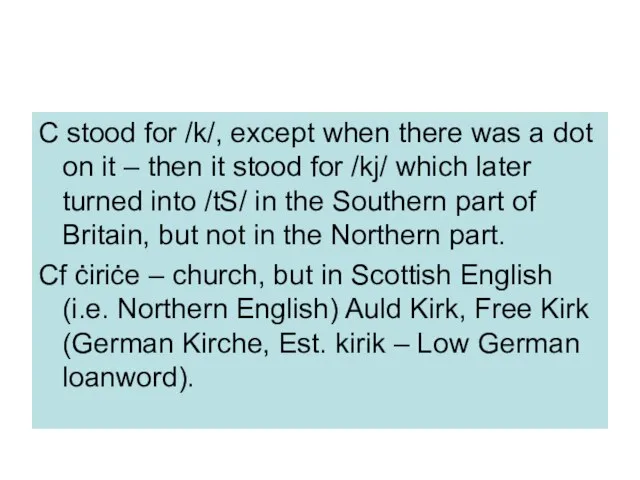
– then it stood for /kj/ which later turned into /tS/ in the Southern part of Britain, but not in the Northern part.
Cf ċiriċe – church, but in Scottish English (i.e. Northern English) Auld Kirk, Free Kirk (German Kirche, Est. kirik – Low German loanword).
Слайд 20Cg – probably /kjkj/ which later turned into
/dž/.

Слайд 21/r/ - trilled, rolled, again preserved in Scottish English.
/r/ was still
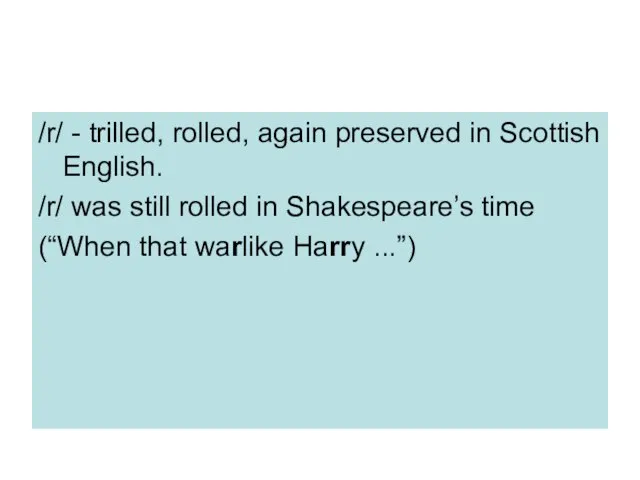
rolled in Shakespeare’s time
(“When that warlike Harry ...”)
Слайд 22h – pronounced in three ways:
At the beginning of a word/syllable –
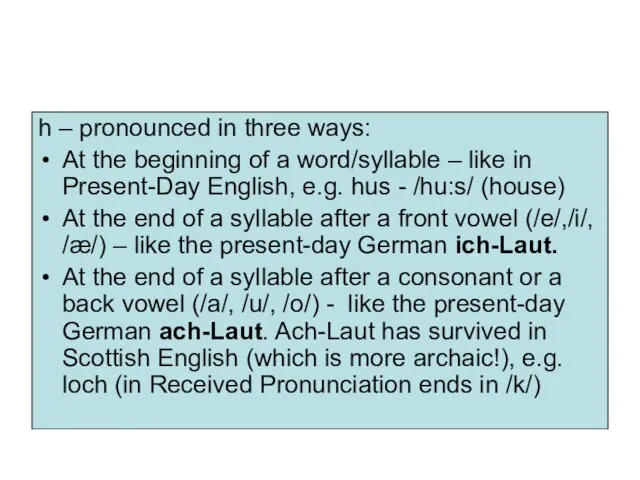
like in Present-Day English, e.g. hus - /hu:s/ (house)
At the end of a syllable after a front vowel (/e/,/i/, /æ/) – like the present-day German ich-Laut.
At the end of a syllable after a consonant or a back vowel (/a/, /u/, /o/) - like the present-day German ach-Laut. Ach-Laut has survived in Scottish English (which is more archaic!), e.g. loch (in Received Pronunciation ends in /k/)
Слайд 23A vowel between /a/ and /o/ (before m and
n). Swedish uses

a special letter - å, Old
English: a and o interchangeably (and/ond).
Слайд 24Phonotactic rules
In every language some sequences of sounds are permitted, others not.
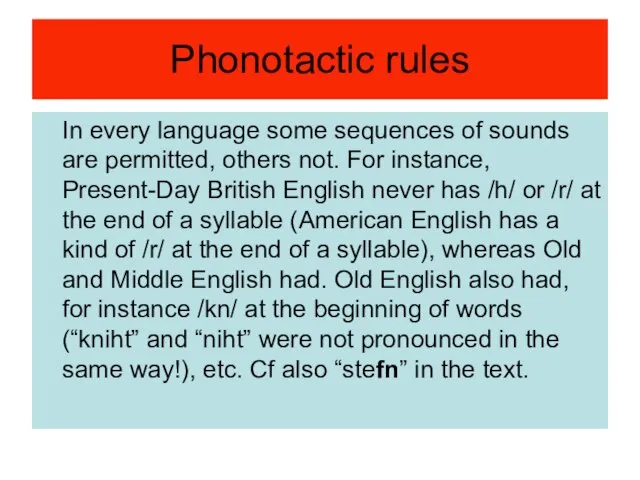
For instance, Present-Day British English never has /h/ or /r/ at the end of a syllable (American English has a kind of /r/ at the end of a syllable), whereas Old and Middle English had. Old English also had, for instance /kn/ at the beginning of words (“kniht” and “niht” were not pronounced in the same way!), etc. Cf also “stefn” in the text.
Слайд 25 For a long time, Estonian did not “permit” consonant clusters at the
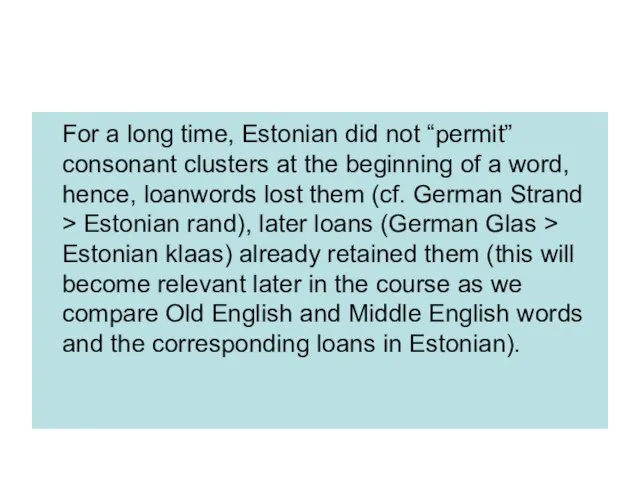
beginning of a word, hence, loanwords lost them (cf. German Strand > Estonian rand), later loans (German Glas > Estonian klaas) already retained them (this will become relevant later in the course as we compare Old English and Middle English words and the corresponding loans in Estonian).
Слайд 26Phonotactic rules account for the so-called
“empty” words – could be in
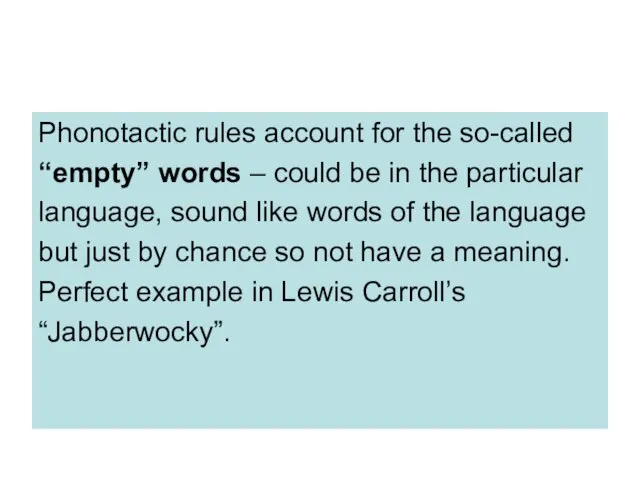
the particular
language, sound like words of the language
but just by chance so not have a meaning.
Perfect example in Lewis Carroll’s
“Jabberwocky”.
Слайд 27JABBERWOCKY
Lewis Carroll
(from Through the Looking-Glass and What Alice Found There, 1872)
First
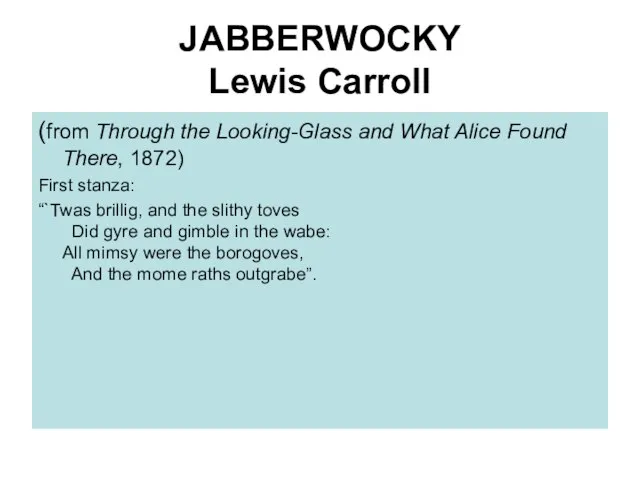
stanza:
“`Twas brillig, and the slithy toves
Did gyre and gimble in the wabe:
All mimsy were the borogoves,
And the mome raths outgrabe”.
Слайд 28The words sound like English words (unlike,
for instance, something like prsotr
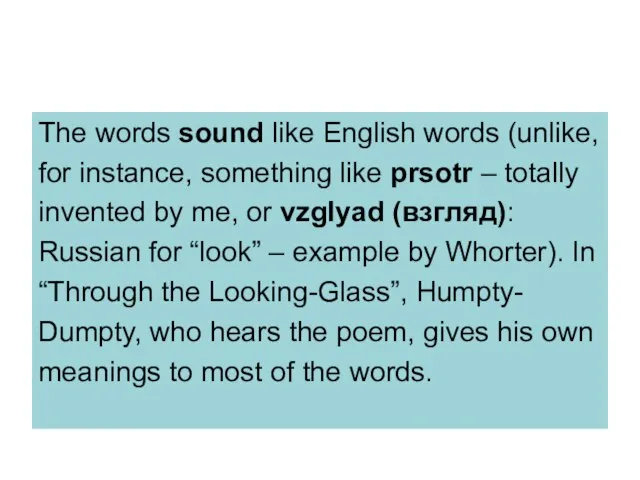
– totally
invented by me, or vzglyad (взгляд):
Russian for “look” – example by Whorter). In
“Through the Looking-Glass”, Humpty-
Dumpty, who hears the poem, gives his own
meanings to most of the words.
Слайд 30(Illustrations to Alice in Wonderland by John Tenniel)
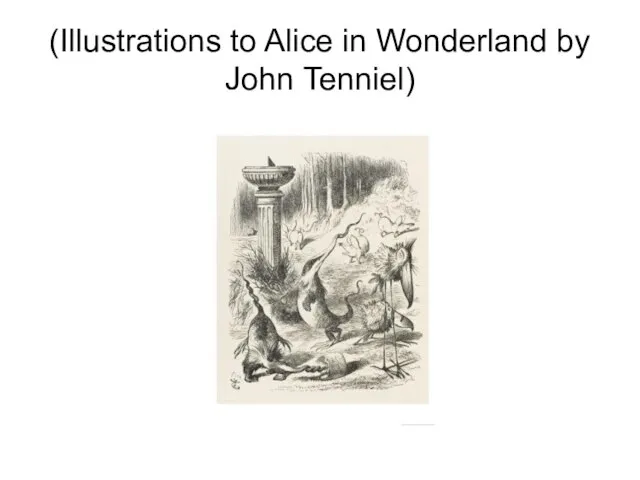



























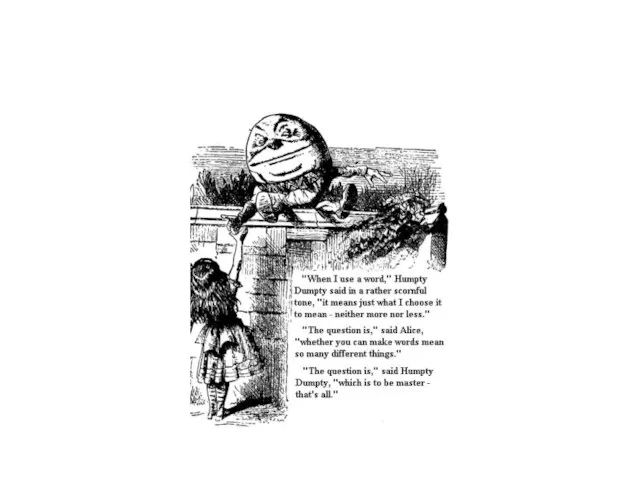

 Учеба по обмену за границей
Учеба по обмену за границей Технология выполнения стебельчатого шва. Монограмма
Технология выполнения стебельчатого шва. Монограмма Информационная карта Технологии развития критического мышления
Информационная карта Технологии развития критического мышления Дистоция плечиков плода
Дистоция плечиков плода РМО ПСИХОЛОГОВ 20.04.11
РМО ПСИХОЛОГОВ 20.04.11 Актуальные вопросы кадрового и методического обеспечения сферы физической культуры и спорта
Актуальные вопросы кадрового и методического обеспечения сферы физической культуры и спорта Romeo and Juliet
Romeo and Juliet Соблюдение лицензионных требований в сфере телерадиовещания
Соблюдение лицензионных требований в сфере телерадиовещания Решение генетических цепочек
Решение генетических цепочек Битва за Москву
Битва за Москву Амины
Амины Научное познание
Научное познание Порядок слов в предложении. Логическое ударение
Порядок слов в предложении. Логическое ударение СПРАВОЧНИК по психологии труда и психологии занятости
СПРАВОЧНИК по психологии труда и психологии занятости Презентация на тему Увеличительные приборы
Презентация на тему Увеличительные приборы  SMM, SEO, Баннеры – в чем отличие?
SMM, SEO, Баннеры – в чем отличие? Деловая риторика и ее значение в межкультурном общении. Тема 7
Деловая риторика и ее значение в межкультурном общении. Тема 7 Что такое квиллинг
Что такое квиллинг Словари
Словари Летучка по теме: «Возбуждение уголовного дела» Подготовила: Миронова Кристина _
Летучка по теме: «Возбуждение уголовного дела» Подготовила: Миронова Кристина _ ТЕМА №3: Эмоции и психические состояния.Свойства личности
ТЕМА №3: Эмоции и психические состояния.Свойства личности Философско-методологические проблемы естествознания
Философско-методологические проблемы естествознания Квиллинг
Квиллинг Человек часть живой природы (3 класс)
Человек часть живой природы (3 класс) Библиотеки мира к международному дню книгодарения
Библиотеки мира к международному дню книгодарения Призма
Призма  Возрождение льна
Возрождение льна Работа силы
Работа силы